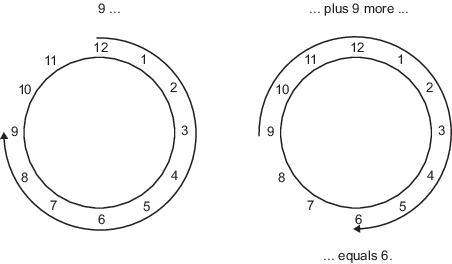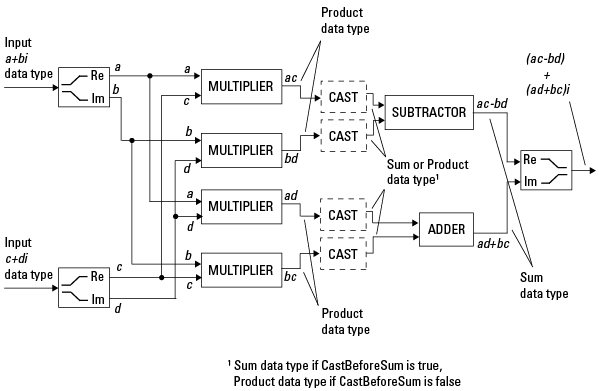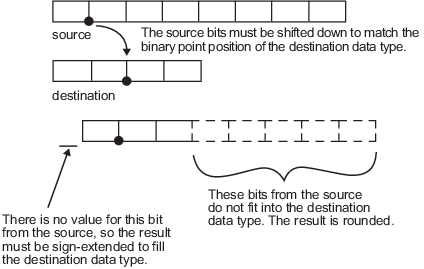Arithmetic Operations
These sections help you understand what data type and scaling choices result in overflows or a loss of precision.
Modulo Arithmetic
Binary math is based on modulo arithmetic. Modulo arithmetic uses only a finite set of numbers, wrapping the results of any calculations that fall outside the given set back into the set.
For example, the common everyday clock uses modulo 12 arithmetic. Numbers in this system can only be 1 through 12. Therefore, in the clock system, 9 plus 9 equals 6. This can be more easily visualized as a number circle:

Similarly, binary math can only use the numbers 0 and 1, and any arithmetic results that fall outside this range are wrapped around the circle to either 0 or 1.
Two's Complement
Two's complement is a way to interpret a binary number. In two's complement, positive numbers always start with a 0 and negative numbers always start with a 1. If the leading bit of a two's complement number is 0, the value is obtained by calculating the standard binary value of the number. If the leading bit of a two's complement number is 1, the value is obtained by assuming that the leftmost bit is negative, and then calculating the binary value of the number. For example,
To compute the negative of a binary number using two's complement,
Take the one's complement, or flip the bits.
Add a 2^(-FL) using binary math, where FL is the fraction length.
Discard any bits carried beyond the original word length.
For example, consider taking the negative of 11010 (-6). First, take the one's complement of the number:
Next, add a 1, wrapping all numbers to 0 or 1:
Addition and Subtraction
The addition of fixed-point numbers requires that the binary points of the addends be aligned. The addition is then performed using binary arithmetic so that no number other than 0 or 1 is used.
For example, consider the addition of 010010.1 (18.5) with 0110.110 (6.75):
Fixed-point subtraction is equivalent to adding while using the two's complement value for any negative values. In subtraction, the addends must be sign-extended to match each other's length. For example, consider subtracting 0110.110 (6.75) from 010010.1 (18.5):
In the Fixed-Point Designer™ software, the CastBeforeSum property of the fimath object has a default value of 1 (true). This casts
addends to the sum data type before addition. Therefore, no further shifting is necessary
during the addition to line up the binary points.
If the CastBeforeSum property has a value of 0
(false), the addends are added with full precision maintained. After the addition, the sum
is then quantized.
Multiplication
The multiplication of two's complement fixed-point numbers is directly analogous to regular decimal multiplication, with the exception that the intermediate results must be sign-extended so that their left sides align before you add them together.
For example, consider the multiplication of 10.11 (-1.25) with 011 (3):

Multiplication Data Types
The following diagrams show how the Fixed-Point Designer software determines data types used for fixed-point multiplication. The diagrams illustrate the differences between the data types used for real-real, complex-real, and complex-complex multiplication.
Real-Real Multiplication. This diagram shows the data types used by the Fixed-Point Designer software in the multiplication of two real numbers. The output of this
operation is returned in the product data type, which is governed by the ProductMode property of the fimath object.

Real-Complex Multiplication. This diagram shows the data types used by the Fixed-Point Designer software in the multiplication of a real and a complex fixed-point number.
Real-complex and complex-real multiplication are equivalent. The software returns the
output of this operation in the product data type, which is governed by the
ProductMode property of the fimath
object:

Complex-Complex Multiplication. This diagram shows the multiplication of two complex fixed-point numbers. The
software returns the output of this operation in the sum data type, which is governed by
the SumMode
property of the fimath object. The intermediate product data type is
determined by the ProductMode property of the
fimath object.

When the CastBeforeSum property of the fimath
object is true, the casts to the sum data type are present after the
multipliers in the preceding diagram. In C code, this is equivalent to
acc = ac; acc- = bd;
for the subtractor, and
acc = ad; acc += bc;
for the adder, where acc is the accumulator. When the
CastBeforeSum property is false, the casts are
not present and the data remains in the product data type before the subtraction and
addition operations.
Multiplication with the fimath Object
These examples show how the ProductMode and
SumMode properties of the fimath object impact
multiplication for real and complex data.
In the following examples, let
F = fimath('ProductMode','FullPrecision',... 'SumMode','FullPrecision'); T1 = numerictype('WordLength',24,'FractionLength',20); T2 = numerictype('WordLength',16,'FractionLength',10); P = fipref; P.FimathDisplay = 'none';
Real*Real. Multiply two real numbers x and y. Notice that
the word length and fraction length of the result z are equal to the
sum of the word lengths and fraction lengths, respectively, of the multiplicands. This
is because the ProductMode and SumMode
properties of the fimath object are set to
FullPrecision.
x = fi(5,T1,F) y = fi(10,T2,F) z = x*y
x =
5
DataTypeMode: Fixed-point: binary point scaling
Signedness: Signed
WordLength: 24
FractionLength: 20
y =
10
DataTypeMode: Fixed-point: binary point scaling
Signedness: Signed
WordLength: 16
FractionLength: 10
z =
50
DataTypeMode: Fixed-point: binary point scaling
Signedness: Signed
WordLength: 40
FractionLength: 30Real*Complex. Multiply real number x with complex number y.
Notice that the word length and fraction length of the result z are
equal to the sum of the word lengths and fraction lengths, respectively, of the
multiplicands. This is because the ProductMode and
SumMode properties of the fimath object are set
to FullPrecision.
x = fi(5,T1,F) y = fi(10+2i,T2,F) z = x*y
x =
5
DataTypeMode: Fixed-point: binary point scaling
Signedness: Signed
WordLength: 24
FractionLength: 20
y =
10.0000 + 2.0000i
DataTypeMode: Fixed-point: binary point scaling
Signedness: Signed
WordLength: 16
FractionLength: 10
z =
50.0000 +10.0000i
DataTypeMode: Fixed-point: binary point scaling
Signedness: Signed
WordLength: 40
FractionLength: 30Complex*Complex. Multiply complex number x with complex number
y. Complex-complex multiplication involves an addition as well as
multiplication. As a result, the word length of the full-precision result has one more
bit than the sum of the word lengths of the multiplicands.
x = fi(5+6i,T1,F) y = fi(10+2i,T2,F) z = x*y
x =
5.0000 + 6.0000i
DataTypeMode: Fixed-point: binary point scaling
Signedness: Signed
WordLength: 24
FractionLength: 20
y =
10.0000 + 2.0000i
DataTypeMode: Fixed-point: binary point scaling
Signedness: Signed
WordLength: 16
FractionLength: 10
z =
38.0000 +70.0000i
DataTypeMode: Fixed-point: binary point scaling
Signedness: Signed
WordLength: 41
FractionLength: 30Casts
The fimath object allows you to specify the data type and scaling of
intermediate sums and products with the SumMode and
ProductMode properties. It is important to keep in mind the
ramifications of each cast when you set the SumMode and
ProductMode properties. Depending upon the data types you select,
overflow and/or rounding might occur. These examples demonstrate cases where overflow and
rounding can occur. For more examples of casting, see Cast fi Objects.
Casting from a Shorter Data Type to a Longer Data Type
Consider the cast of a nonzero number, represented by a 4-bit data type with two fractional bits to an 8-bit data type with seven fractional bits.

As the diagram shows, the source bits are shifted up so that the binary point matches the destination binary point position. The highest source bit does not fit, so overflow might occur and the result can saturate or wrap. The empty bits at the low end of the destination data type are padded with either 0's or 1's.
If overflow does not occur, the empty bits are padded with 0's.
If wrapping occurs, the empty bits are padded with 0's.
If saturation occurs,
The empty bits of a positive number are padded with 1's.
The empty bits of a negative number are padded with 0's.
Even with a cast from a shorter data type to a longer data type, overflow might still occur. This can happen when the integer length of the source data type (in this case two) is longer than the integer length of the destination data type (in this case one). Similarly, rounding might be necessary even when casting from a shorter data type to a longer data type if the destination data type and scaling has fewer fractional bits than the source.
Casting from a Longer Data Type to a Shorter Data Type
Consider the cast of a nonzero number, represented by an 8-bit data type with seven fractional bits, to a 4-bit data type with two fractional bits.

As the diagram shows, the source bits are shifted down so that the binary point matches the destination binary point position. There is no value for the highest bit from the source, so sign extension is used to fill the integer portion of the destination data type. Sign extension is the addition of bits that have the value of the most significant bits to the high end of a two's complement number. Sign extension does not change the value of the binary number. In this example, the bottom five bits of the source do not fit into the fraction length of the destination. Therefore, precision can be lost as the result is rounded.
In this case, even though the cast is from a longer data type to a shorter data type, all the integer bits are maintained. Conversely, full precision can be maintained even if you cast to a shorter data type, as long as the fraction length of the destination data type is the same length or longer than the fraction length of the source data type. In that case, however, bits are lost from the high end of the result and overflow can occur.
The worst case occurs when both the integer length and the fraction length of the destination data type are shorter than those of the source data type and scaling. In that case, both overflow and a loss of precision can occur.